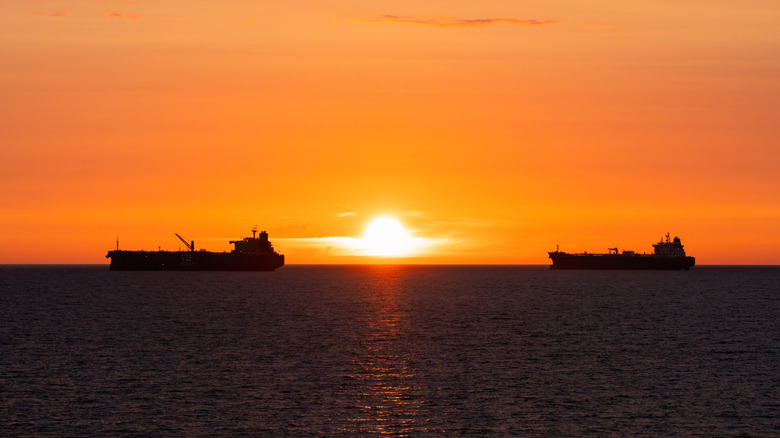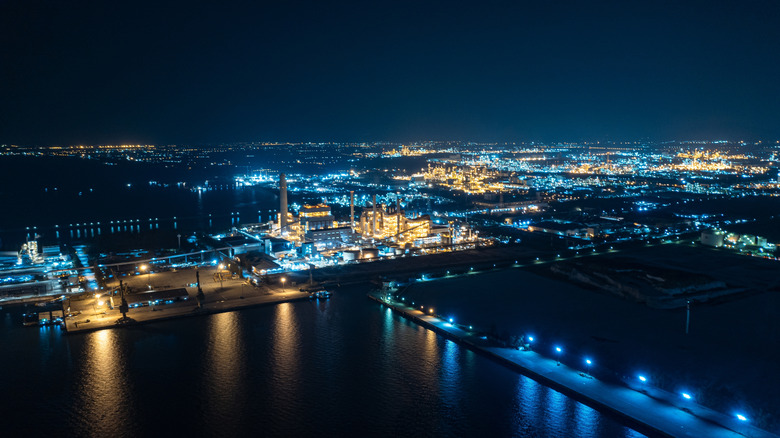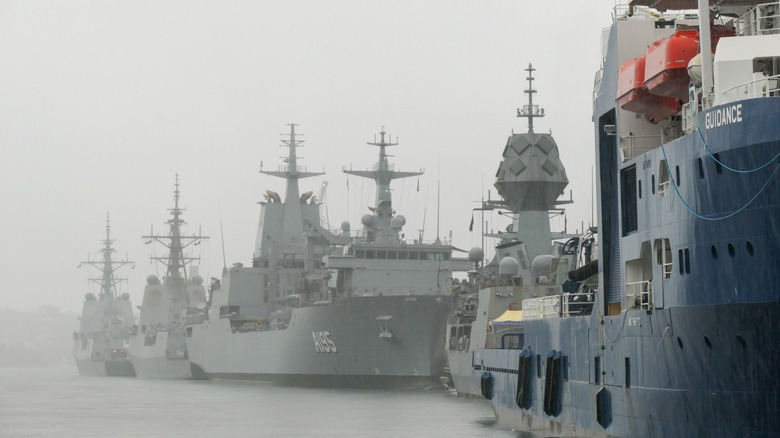How Many Ships Could Be In The Russian Navy's 'Shadow Fleet'?
Ever since Russia invaded Ukraine in 2022, most of the world has called for Russia to retreat back to its own territory and end the war. Almost immediately, a slew of economic sanctions were imposed on Russia by the U.S., U.K., European Union, and other allies. These sanctions, building on pre-existing ones initiated after Russia annexed Crimea in 2014, aim to hurt Russia's economy and incentivize its government to cease the invasion. They strategically target specific parts of Russia's economy, such as its financial sector, aerospace and aviation industries, and other important sectors.
Due to the fact a great deal of Russia's economy is based on its energy production and exports, sanctions are also focused on energy and shipping — keeping the nation from selling its oil and other resources and earning more money to fund its invasion of Ukraine. However, Russia has been circumventing these sanctions by using legal loopholes, shell companies, and a fleet of old tankers that enable the country to still make money off its energy exports. This "shadow fleet" takes advantage of inspection and enforcement oversights to continue trade and undermine efforts to hurt Russia's economy.
Additionally, shadow fleet ships will turn off their AIS (Automatic Identification System) signals, hiding their locations from other ships, and transfer oil and cargo from one ship to another in the middle of the ocean, as well as change flags and identification mid-route to make them harder to track. The more ships Russia adds to its shadow fleet, the more oil the country can sell — and the more profit it can earn. Since the fleet operates so nebulously, it's hard to keep track of the exact number of ships involved. Estimates range from 350 to nearly 600 vessels currently comprising Russia's shadow fleet. Some estimates even go as high as 900 ships.
The shadow fleet undermines efforts to stop the invasion of Ukraine
With hundreds of ships, Russia's shadow fleet may comprise approximately 10% of all ships carrying wet cargo around the world. It's estimated to carry around 1.7 million barrels of oil per day; with the price of oil recently around $65 to $75, these shadow exports are adding hundreds of millions, if not more, to Russia's war chest. At the time of writing, the ongoing war between Russia and Ukraine has already cost hundreds of thousands of civilians' and soldiers' lives, and disrupted global order — perhaps irreversibly.
Other nations have been hesitant to directly join the war and expand the conflict, so sanctions have been a key way for Ukraine's allies, including Europe and the U.S., to repel Russia's invasion. The success of the shadow fleet's trade revenue flies directly in the face of these sanctions. Plus, the shadow fleet may be doing even more harm than skirting sanctions. There are reports that some ships in the fleet are actively sabotaging Russia's enemies, including tankers that have damaged vitally important submarine cables.
Another danger the shadow fleet of older tankers pose is that, because they're aged and free from standard inspections and regulations, they're more likely to cause environmental disasters. Oil spills resulting from shadow fleet vessels have already been alleged to have occurred. The fact that shadow fleet ships are often uninsured make these disasters even more costly — and Russia is unlikely to foot the bill.
Officials are calling on governments to do more to stop the shadow fleet
Russian warships have been sunk during its war with Ukraine, but its shadow fleet of oil tankers clearly also pose a threat. The governments of Ukraine's allies are increasingly facing pressure to do more to dismantle Russia's shadow fleet, as the war shows no signs of ending anytime soon. Recently, EU ministers called for more coordinated action between the countries to better restrict Russia's oil trade. Additionally, there are calls for increased transparency, regulation, and monitoring of maritime trade parties and practices, as well as crackdowns on shell companies — including those in the U.K., Hong Kong, the U.A.E., and other jurisdictions outside of Russia — that are facilitating the shadow fleet's actions.
With a war between Iran and Israel threatening to become a major global conflict, the move to enforce sanctions are likely to intensify. Maritime trade in the region may become more risky if two of the most powerful nations in the Middle East engage in a full-scale war (Iran has an aircraft carrier). Plus, Iran is a Russian ally. Iran has also learned to evade the impact of sanctions, as it has been subject to them for decades. It's also believed that Iran has used its experience and collaborated with Russia to help build its shadow fleet and increase its effectiveness. As tensions around the globe continue to heat up, it'll be likely that the E.U., U.K., U.S. and other allies make a more concentrated effort to reduce the number of ships in Russia's secret fleet — ideally down to zero.


